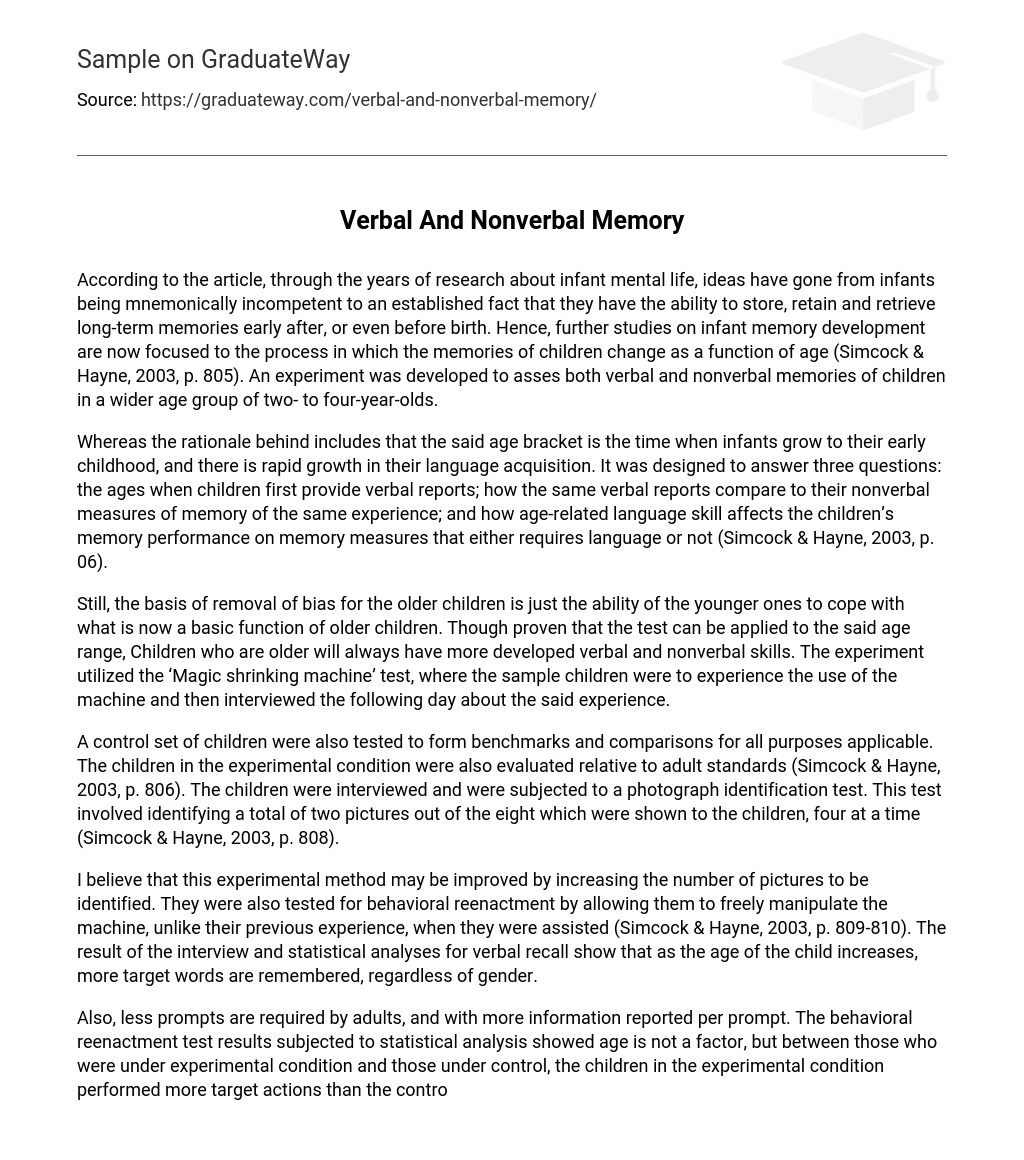According to the article, through the years of research about infant mental life, ideas have gone from infants being mnemonically incompetent to an established fact that they have the ability to store, retain and retrieve long-term memories early after, or even before birth. Hence, further studies on infant memory development are now focused to the process in which the memories of children change as a function of age (Simcock & Hayne, 2003, p. 805). An experiment was developed to asses both verbal and nonverbal memories of children in a wider age group of two- to four-year-olds.
Whereas the rationale behind includes that the said age bracket is the time when infants grow to their early childhood, and there is rapid growth in their language acquisition. It was designed to answer three questions: the ages when children first provide verbal reports; how the same verbal reports compare to their nonverbal measures of memory of the same experience; and how age-related language skill affects the children’s memory performance on memory measures that either requires language or not (Simcock & Hayne, 2003, p. 06).
Still, the basis of removal of bias for the older children is just the ability of the younger ones to cope with what is now a basic function of older children. Though proven that the test can be applied to the said age range, Children who are older will always have more developed verbal and nonverbal skills. The experiment utilized the ‘Magic shrinking machine’ test, where the sample children were to experience the use of the machine and then interviewed the following day about the said experience.
A control set of children were also tested to form benchmarks and comparisons for all purposes applicable. The children in the experimental condition were also evaluated relative to adult standards (Simcock & Hayne, 2003, p. 806). The children were interviewed and were subjected to a photograph identification test. This test involved identifying a total of two pictures out of the eight which were shown to the children, four at a time (Simcock & Hayne, 2003, p. 808).
I believe that this experimental method may be improved by increasing the number of pictures to be identified. They were also tested for behavioral reenactment by allowing them to freely manipulate the machine, unlike their previous experience, when they were assisted (Simcock & Hayne, 2003, p. 809-810). The result of the interview and statistical analyses for verbal recall show that as the age of the child increases, more target words are remembered, regardless of gender.
Also, less prompts are required by adults, and with more information reported per prompt. The behavioral reenactment test results subjected to statistical analysis showed age is not a factor, but between those who were under experimental condition and those under control, the children in the experimental condition performed more target actions than the control. In the photograph identification test, it was found that the score in remembering the photos in the two sets are directly proportional to age.
Scores that may have been due to chance were eliminated by one-sample t-test. Based on the findings, the addition of recognizable photos and verbal recall did not enhance behavioral reenactment. In terms of language skill, it was found that it is directly proportional with age. Verbal skill and verbal recall were found to increase with age, even the potential words that the children could have reported.
Additionally, there is significant correlation between verbal skill and nonverbal recall (Simcock & Hayne, 2003, p. 810-811). According to Simcock and Hayne, 2003, children with more mature language abilities are able to make better representations of events that they experience, hence, verbal skill might be the factor that facilitates original encoding and those with wider vocabulary might have understood instructions better, giving better reactions when given cues in the test.
Additionally those with advance language skills might have been more likely to come across retrieval cues in the 24-hour interval, giving them better memory (p. 812). The article suggests that even with wide and advanced language, it is still not enough for children, specifically aged two to four years of age, to have adequate verbal representations of the past. Also, it is a prerequisite for a pre-school child to represent memories verbally before he can actually remember them.
The development of children’s verbal skill is a long period, and coincidentally, during this stage does the child overcome childhood amnesia (Simcock & Hayne, 2003, p. 805). The idea that Simcock and Hayne proposed are very plausible and the experimental method they used is an important tool for further research for they have made a test that encompasses a greater age range than of previous tests regarding infant memory.





